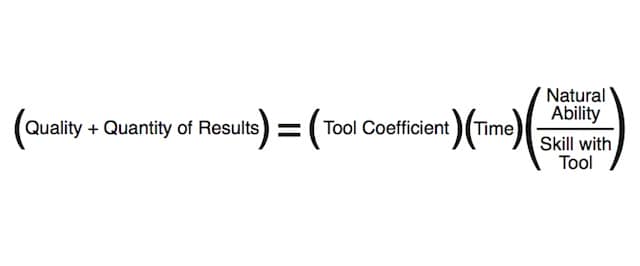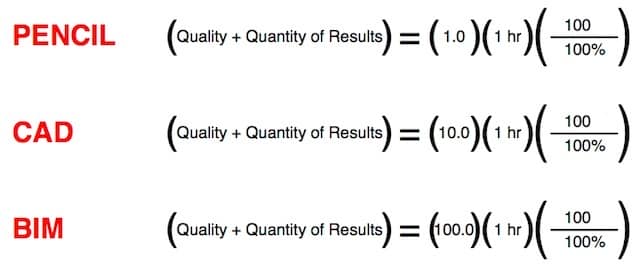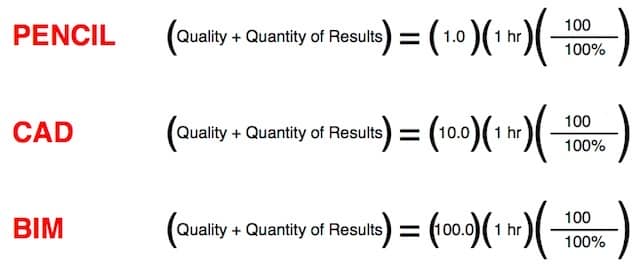Today on Twitter, in response to this post about the most amazing BIMx model I’ve seen, I saw a Tweet that went like this:
“4all their power computers are just tools #architects still need 2do the hard work of #design”
Yes, but. Anyone who thinks using computers is about making things easier is wrong. Well maybe not wrong, but missing the bigger picture. Using computers (and technology in general) is about being able to harness more power. It’s about being able to apply a force multiplier to our available skill. Think about this example. You and I are going to have a race. First one to go from Boston to New York wins. You’re going to run in bare feet, abstaining from any technology. I’m going to drive my car. Who’s going to win?
You can’t run 200 MPH but you can go that fast in a Ferrari
Tools are tools. And I’m going to write some more about that later this week, but for now mull over this equation:
 The idea here is that the quality and quantity of your output is controlled by how good your tool is, the time you have, how good you are with the particular tool, and then of course your natural ability (raw talent). Let’s make a couple of assumptions now about this equation. Your natural ability goes from 0 (I have a 0% ability to fly) to 100 (pick your favorite architect, he or she is the best possible). Your skill with a tool goes from 0% to 100%. So many of my old bosses had 0% skill with BIM, but a few of them probably had close to 100% ability with a pencil. I’ve written about one of them before. You should read that post because it is VERY relevant to this equation.
The idea here is that the quality and quantity of your output is controlled by how good your tool is, the time you have, how good you are with the particular tool, and then of course your natural ability (raw talent). Let’s make a couple of assumptions now about this equation. Your natural ability goes from 0 (I have a 0% ability to fly) to 100 (pick your favorite architect, he or she is the best possible). Your skill with a tool goes from 0% to 100%. So many of my old bosses had 0% skill with BIM, but a few of them probably had close to 100% ability with a pencil. I’ve written about one of them before. You should read that post because it is VERY relevant to this equation.
Now let’s plug in some numbers and look at three idealized architects. Each scores 100 on natural ability and 100% on their skill with their chosen tool. For Tool Coefficient, I’ve set pencil to 1.0 (as a baseline) and extrapolated from there. Feel free to argue about those numbers in the comments, if you’d like.
 Controlling for time, skill, and ability, who’s going to produce the most results of the highest quality? Here’s the thing. I’m 100% confident we’ve all seen, met, or read about the first architect in this example. The Perfect Pencil Architect. The history of 20th Century Architecture is filled with examples. But did anyone ever reach that pinnacle with CAD? No way. No one cared to. When CAD was the most advanced technology (was it ever?), computers were slow and our education didn’t value computers as a design tool. The best designers probably saw CAD as a liability to their creative abilities. The pay off wasn’t there because the skill curve was not worth it. The Perfect CAD Architect probably never did, and never will exist.
Controlling for time, skill, and ability, who’s going to produce the most results of the highest quality? Here’s the thing. I’m 100% confident we’ve all seen, met, or read about the first architect in this example. The Perfect Pencil Architect. The history of 20th Century Architecture is filled with examples. But did anyone ever reach that pinnacle with CAD? No way. No one cared to. When CAD was the most advanced technology (was it ever?), computers were slow and our education didn’t value computers as a design tool. The best designers probably saw CAD as a liability to their creative abilities. The pay off wasn’t there because the skill curve was not worth it. The Perfect CAD Architect probably never did, and never will exist.
The era of BIM is different. Not only is the software so much more powerful, the computers we are using are as well. Our architecture schools are also starting to get it. There are professors that were raised in the computer age. Professors that played video games growing up and used computers in schools themselves. And the student population is approaching 100% digital natives. Architecture students don’t need to learn how to use a computer AND a software program. The computers are invisible. The students have probably been using them since before they can remember. Sure there’s still a bunch of crap digital architecture out there, but how many buildings can you name that benefited from being designed and documented digitally? We haven’t seen the 100% BIM skill Architect yet, and the tools (as exemplified by BIM) keep getting better, faster, and stronger. Perhaps this year, or maybe next year, and definitely before 2030 we’ll see that Perfect BIM Architect. We’ll meet that Architect who would have been a Louis Kahn half a century ago, but because of his or her access to some insanely amazing tools will be something you and I can’t even comprehend today.
What do you think? Are the best Architects of the 21st Century going to be more amazing, more prolific, and more influential than the masters of the 20th Century? Or did we peak with Ludwig Mies van der Rohe and Le Corbusier?
Let’s move beyond the “computers are just tools” discussions and get deeper into the real issues of being an Architect in the 21st Century. Okay? Well one last thing: did you notice the subliminal message in that Tweet I quoted about design being the realm of 2D tools? Or is that just me over-analyzing from my soapbox? Subscribe to my blog to learn more about how to become the Perfect BIM Architect (and so much more): Shoegnome on Facebook, Twitter, and sign up for the RSS feed.

15 thoughts on “It Happened Again: someone reminded me that Computers are Just Tools”
I will say this about BIM, it opens up a whole lot more possibilities… most of which may cause efficiency road blocks. When I started working I was a draftsperson/junior designer use AutoCAD. Design was an easy path, clients generally don’t understand the 2d output so they have some trust that it all works out (I mean thats why the hired you right?).
For the past 8 years I’ve been using ArchiCAD, which gives the client a whole new perspective on the design at very early stages. This consistently inspires them to contribute design input, and nothing is a bigger time suck than client involvement. I saw a comic (wish I could find it now) about a client asking his designer “whats the fee?”, “$60/hr”; “what if I want to come in and respond to some of the concepts”, “$100/hr”; “what if I want to help with the drawing/modeling?”, “150/hr”; “what if I just need you to draw/model my ideas”, “$500/hr”… or something along those lines.
All that being said, the houses I have worked on and designed over the last 8 years have been a very thorough collaboration between our clients, architects, interior designers, engineers, mechanical consultants, design review boards, etc… Which I would call a better end product, but a longer process.
I guess using the barefoot to Ferrari comparison; the Ferrari runs circles around the runner, and we do end up running in circles through most projects. Maybe my process is broken, but I think the end justifies the means. We make it to new york from boston, but normally take the scenic route… (which in a Ferrari is still faster than barefoot).
Love it. “the scenic route”. That’s so spot on. And why BIM can lead to disaster. Starting in Boston people get into the Ferrari, point to NYC, then run out of gas somewhere between Cleveland and Chicago.
Also if you ever find that comic let me know. Sounds way too perfect.
to get with that result with BIM you have first to make people understand whats the meaning of that really i had this problem with the engineering community in my city so u have to make this thought raising up with your own capability and thats so hard in my case even with my own deep believing in its benefits
Good point. The barriers to reaching the ideal BIM Architect are much more complex than just mastery of the tool at hand. Architectural practice, especially the use of BIM, involves interacting with so many others that raising group awareness and understanding is a huge requirement for success.
Pingback: Of Bows and Arrows and Machine Guns » Shoegnome
Pingback: Architects are really just asking for Haptic Feedback » Shoegnome
Pingback: Is the 21st century pencil the better tool Architects are looking for?
Pingback: How NOT to talk about BIM: losing control of the message » Shoegnome
Pingback: Design like an Architect » Shoegnome
The ferrari is great, until you’re stuck in traffic. Some people would rather not drive, they take the bus or even have a chauffeur. Architecture is so much more than the documentation, you can hire people to do the BIM. So yes, like a draughtsman, it’s just a tool,…. a very powerful tool.
I do like your extension of the analogy. I have definitely gotten stuck in traffic and watched other people getting driven around, not much noticing the lack of movement… What I think haunts the industry is that people have just hired and outsourced BIM like it’s a replacement for a draughtsman. But it’s potentially so much more. At some point the lead designer and the BIM guru will merge into one. And if you are just the designer or just the draughtsman at that point, then you become a bit redundant.
A bit of hypocrisy, as I was playing devils advocate, because I am a one man show, and like it that way. On the occasion that I have hired someone, I find it costs more time than it saves, even with a large part of my work being low cost repetitive housing.
But I have also forced myself to design with BIM. At first is seems to take longer than a pencil, and a lot less freedom, I spend a lot of time just orbiting around in 3d, but then, there is no irritating phase of converting sketches into reality, where sometimes they don’t work too well, and then explaining to the client that things had to change.
I will usually use sketchy renderings in the early stages with a client, because somehow when a line is sketchy, people understand that it is still a concept, not yet cast in stone.
I’m in that transition point in my business where I need to figure out how to outsource some of the work effectively or rethink what I want my business to be. Not an easy task. I should write a post about orbiting around in 3D. It can be so intoxicating sometimes. But it can also be super useful to understanding. Sometimes. Sometimes it’s just the equivalent of retracing something you’ve already drawn-you know when your brain is shut off and you need to still keep working, but you don’t have anything useful to add! 🙂
or sometimes it’s just a way to make it look like your working to your bosses. An old joke from a previous job was “panning around the plan”. It was how we made ourselves look like we were working when we were really just bored, goofing off, or tired.
I must admit though, I never found CAD to be anything more than a glorified drawing board, until I discovered BIM (Archicad 6), Then it made sense as it could really do so much more.
Pingback: BIM advice from Pantera's Reinventing the Steel - Shoegnome